History
The name Myshall “Midh Íseal” means 'low plain' and the village also
gives its name to the towns land and parish. The buildings which were
prominent when the village was planned in the 17th century are now
domestic residences, shops and bars but retain their charm of former
days.
SAINT FORTCHERN AND SAINT FINIAN
Fortchern became a scholar and a skilled craftsman in metal work and when he became a monk he devoted his talents to making sacred vessels, statues, crosses and bells and it was he who fashioned the famous image of the Madonna which was enshrined for centuries in the Monastic Chapel at Trim. St. Fortchern is depicted as a craftsman in a stained glass window at the Church of the Sacred Heart, Borris.
HISTORICAL BALLADS
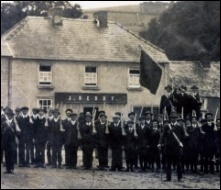 The
Myshall Volunteers were started in 1914 with 40 - 50 members. There was another
volunteer group in Coolasnaughta and also one in Cranemore with 23 members in
that one. Laurence Fitzpatrick trained the Myshall lads and worked at Byrne’s of
the Bawn. They used wooden guns made by a local carpenter. This song may have
been made up by a stranger working at Pat Fenelon’s Shangarry. It was preserved
by the late Tommy Dobbs who actually remembered seeing the green and gold flag
of the Volunteers.
The
Myshall Volunteers were started in 1914 with 40 - 50 members. There was another
volunteer group in Coolasnaughta and also one in Cranemore with 23 members in
that one. Laurence Fitzpatrick trained the Myshall lads and worked at Byrne’s of
the Bawn. They used wooden guns made by a local carpenter. This song may have
been made up by a stranger working at Pat Fenelon’s Shangarry. It was preserved
by the late Tommy Dobbs who actually remembered seeing the green and gold flag
of the Volunteers.
SCHOOLS OF THE PAST
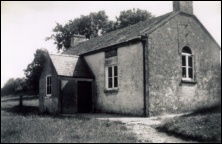 The
earliest information on primary schools in the Myshall/Drumphea area is taken
from ‘Schools of Kildare and Leighlin A.D.1775-1835’ by Rev. Martin Brennan,
M.S. B.D. PhD published by M.H. Gill and Son Ltd 1935. It appears the
information was given by Laurence Cummins P.P. 1816 – 1838.
The
earliest information on primary schools in the Myshall/Drumphea area is taken
from ‘Schools of Kildare and Leighlin A.D.1775-1835’ by Rev. Martin Brennan,
M.S. B.D. PhD published by M.H. Gill and Son Ltd 1935. It appears the
information was given by Laurence Cummins P.P. 1816 – 1838.
RATHNAGEERAGH SCHOOL
The initial application for a schoolhouse at Rathnageeragh states it was in the parish of Fenagh, the site was 1 rood, it was non vested, built by local funds in 1883 – a new house, one story high, slate roof, with four large windows, two on the front and two on the back, a door on the end, the condition of the house was judged to be excellent consisting of one schoolroom. And so a schoolhouse was built and sanctioned and paid for by local funds at Rathnageeragh the precise date of opening as a school was 11th January 1864 and as a National School was 1st April 1864.
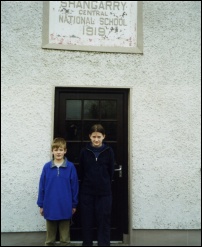 SHANGARRY SCHOOL
SHANGARRY SCHOOL
Shangarry Central National School opened in 1919 as a two teacher Church of Ireland N.S. In the early days it had an enrolment of 40 –50 pupils. But sadly with only two pupils left in the school – the smallest enrolment in Ireland, the school closed its doors for the final time on Wednesday 27th June 2001. Mrs. Myra Bradley taught in the school for 41 years and retired in 1998. She was appointed Principal of Shangarry School in 1957, when she replaced Mrs. Parker. There were 14 children on rolls then.
GARRYHILL SCHOOL
The building process of the current school in Garryhill began in 1935 and the official opening of the new school took place the following year when Fr. Breen C.C. Bagenalstown said the Mass at the official opening. But education in Garryhill goes back much further and synonymous with Garryhill National School is the ‘Ryan’ family. Originally there had been a National and Agricultural school in Garryhill at the site of the Walsh family home now.
GARRYHILL HALL
Almost every area in rural Ireland had an F.C.A. (Fórsa Cosanta Áitiúl), branch in the late 40’s and early 50’s and on its formation in 1946 a platoon in Garryhill found itself with 27 volunteers. Most areas had a proper hall for their headquarters but in Garryhill there was no barrack square, no hall, no desks or blackboards, no rifle rests and no place where the pennant could be planted. But in the true spirit of the new born ‘Fórsa’ the Garryhill boys were determined to become soldiers no matter what obstacles might be in the way. First they drilled on the roadside and used one another’s houses for instruction on wet nights and planned and plotted until a site was acquired and an old Army hut erected.
GARRYHILL HOUSE & COTTAGE INDUSTRY
Garryhill House was built by the Earl of Bessborough between 1740 and 1760 – Earl of Bessborough is a title in the Peerage of Ireland. The first Earl was called Brabazon Ponsonby who lived from 1679–1758 and he was promoted to Earl in 1739 from Viscount Duncannon and given lands in Ireland. Lord Bessborough owned 23,967 acres in Co. Kilkenny with an official evaluation of £15,484 and 10,578 acres in Co. Carlow with an official evaluation of £5,522 of which Garryhill was a part.
NAOMH EOIN 1968 - THE DAWN OF A NEW ERA
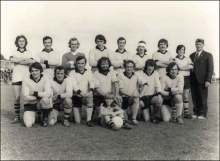 “Time nor Tide waits for no man,” and it’s hard to believe that forty years has
passed since one eventful meeting that was held in Garryhill Hall on a Sunday in
January 1968. The aim of the meeting was to have a hurling and football club
uniting all parts of the parish and its environs. A big group of young and not
so young men were kicking football on the green park in front of the Hall before
the meeting started.
“Time nor Tide waits for no man,” and it’s hard to believe that forty years has
passed since one eventful meeting that was held in Garryhill Hall on a Sunday in
January 1968. The aim of the meeting was to have a hurling and football club
uniting all parts of the parish and its environs. A big group of young and not
so young men were kicking football on the green park in front of the Hall before
the meeting started.
MYSHALL CAMOGIE "BLUES"
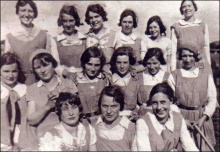 A team started in
Myshall in the early 30’s called Myshall Crusaders and members of this
team were: Maggie Murphy, Myshall; Kathleen Murphy, Myshall; May Murphy,
Myshall; Bridget Murphy (Mrs. Dunne Myshall); Molly Fox, Shangarry;
Katie Fox Shangarry; Kathy O’ Neill; Maggie O’ Neill Shangarry; Margaret
Bennet, Ballaghmore; Mary and Annie McDonald Moneygrath; Julia Cleary
Ballinacrea who played in goal, Agnes Keogh Coolasheegaun; Mai Keogh
Aclare. This team only lasted a short time and they joined the “Blues”
or gave up playing altogether.
A team started in
Myshall in the early 30’s called Myshall Crusaders and members of this
team were: Maggie Murphy, Myshall; Kathleen Murphy, Myshall; May Murphy,
Myshall; Bridget Murphy (Mrs. Dunne Myshall); Molly Fox, Shangarry;
Katie Fox Shangarry; Kathy O’ Neill; Maggie O’ Neill Shangarry; Margaret
Bennet, Ballaghmore; Mary and Annie McDonald Moneygrath; Julia Cleary
Ballinacrea who played in goal, Agnes Keogh Coolasheegaun; Mai Keogh
Aclare. This team only lasted a short time and they joined the “Blues”
or gave up playing altogether.
GARRYHILL CAMOGIE CLUB
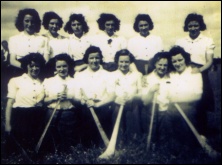 The first camogie team was formed in Garryhill about 1933 called
Garryhill Rovers. The uniform was green gymslip and white blouses with
gold trim. This was later changed to navy, white/cream and green.
The first camogie team was formed in Garryhill about 1933 called
Garryhill Rovers. The uniform was green gymslip and white blouses with
gold trim. This was later changed to navy, white/cream and green.
Practices took place in a field called the ‘Millmore’ so called because there was an old mill in the area and the local lads practiced football and hurling in the same field as did the Booldurragh Tug-o-war team.
GARRYHILL PITCH AND PUTT CLUB
Garryhill Pitch and Putt club was founded in 1967 under the chairmanship of Fr. O’Shea who was then a curate in Myshall Parish. The first secretary/treasurer of the club was Mrs. Cecilia Ryan a position she held up to 1974. The course was established on grounds owned by Miss Millie O’Connell who very kindly gave free use of the land in the first year. To raise funds the club ran several Goose clubs at Christmas Time but members socialised a lot and held a Dinner Dance annually in the Slaney Hotel Tullow.
MOUNT LEINSTER, SUIDHE LAIGHEAN
 Meeting Place of the Men of Leinster
Meeting Place of the Men of Leinster
The 2,610 feet summit is crowned with a sepulchral cairn (buried site) dating from the first century of the Christian era and marking the grace of the Cucorb King of Leinster who was slain in battle at the foot of the mountain by Fedhlimidh Reachtmhar, King of Ireland, who was himself slain in 199 A.D. Tradition holds with the theory that when a king or chieftain was killed he should be buried at the highest point of land in the area.
The television mast which now acts as a landmark was erected in 1960.
Nearby Sliabh Ban has a smaller cairn and stone chamber and marks
another grave from early Christian times.
NINE STONES, SLIEVEBAWN
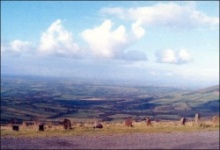 The true origin of a famous landmark known as “The Nine Stones” is
lost in antiquity. The stones are probably of the early or pre-Christian
era when nine was a mystical number being a trinity of trinities etc.,
but varying traditions mark it as: the final resting place of nine
chieftains; a place where nine rebels were killed; the burial place of
1798 heroes killed by Yoemen returning from the battle of Newtownbarry
(Bunclody); or the burial place of nine shepherds. A custom in the old
days was for those passing to place a small stone on the graves of those
buried there.
The true origin of a famous landmark known as “The Nine Stones” is
lost in antiquity. The stones are probably of the early or pre-Christian
era when nine was a mystical number being a trinity of trinities etc.,
but varying traditions mark it as: the final resting place of nine
chieftains; a place where nine rebels were killed; the burial place of
1798 heroes killed by Yoemen returning from the battle of Newtownbarry
(Bunclody); or the burial place of nine shepherds. A custom in the old
days was for those passing to place a small stone on the graves of those
buried there.
 1798 PERIOD OF UNREST IN THE AREA
1798 PERIOD OF UNREST IN THE AREA
Myshall/Drumphea is an area steeped in 1798 memories and the two men most associated with the rebellion in Myshall were the Rebel leader Captain James Nolan and the local magistrate and landlord Robert Cornwall who resided at Myshall Lodge a building situated where the Lawn is now, in fact the Lawn was that of the big house. The following is a summary of some of the information collected by the ‘98 Commemoration Committee in 1998.
1798 BI-CENTENARY COMMERORATION COMMITTEE
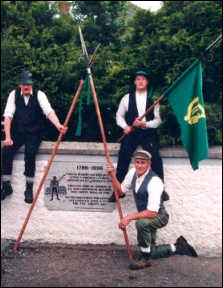 Towards the end of 1997 a small committee was formed to commemorate
the bi-centenary of 1798. Their aims were threefold - to discover as
much as possible about 1798 in the area; to commemorate these events and
to attract tourists and visitors to the area for these commemorations.
However, like all small committees it had big ideas and all ideas focused around
the two traditions that were known in the area relating to 1798 - the
last Mass of Fr. John Murphy and the making of the Croppy Road. As this
latter was thought to have been one of the first negotiations made
through peaceful means the committee soon adopted a theme of “Roads to
Peace and Progress”. It was decided to erect a plaque on this Croppy
Road and to have a 200th Commemoration Mass in honour of the rebel
Priest who honoured the area two hundred years before.
Towards the end of 1997 a small committee was formed to commemorate
the bi-centenary of 1798. Their aims were threefold - to discover as
much as possible about 1798 in the area; to commemorate these events and
to attract tourists and visitors to the area for these commemorations.
However, like all small committees it had big ideas and all ideas focused around
the two traditions that were known in the area relating to 1798 - the
last Mass of Fr. John Murphy and the making of the Croppy Road. As this
latter was thought to have been one of the first negotiations made
through peaceful means the committee soon adopted a theme of “Roads to
Peace and Progress”. It was decided to erect a plaque on this Croppy
Road and to have a 200th Commemoration Mass in honour of the rebel
Priest who honoured the area two hundred years before.
ADELAIDE MEMORIAL CHURCH & CEMETERY
(Church of Ireland)
The Adelaide Memorial Church of Christ the Redeemer is an architectural gem. Its origins are traced back to a love story which ended in tragedy. It replaces an earlier Church of Ireland building dating from 1811.
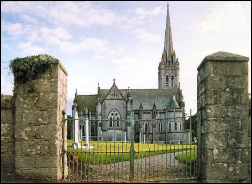 Miss Constance Eugenie Duguid, a daughter of an English businessman,
visited her sister in 1887 at her home in Myshall. Her sister was
married to the curate of Fenagh and Myshall and resided in Myshall Glebe. Constance
became engaged to a
member of the Brady family who lived in Myshall Lodge but before the
happy event took place she was thrown from her horse and died soon
afterwards. She was buried in the hillside churchyard close to the
mountains and open countryside she loved. Later her parents erected over
her grave a marble copy of a statue of Innocence which she admired when
on holidays in Italy. A few years later her mother died and by her wish
was buried alongside her daughter.
Miss Constance Eugenie Duguid, a daughter of an English businessman,
visited her sister in 1887 at her home in Myshall. Her sister was
married to the curate of Fenagh and Myshall and resided in Myshall Glebe. Constance
became engaged to a
member of the Brady family who lived in Myshall Lodge but before the
happy event took place she was thrown from her horse and died soon
afterwards. She was buried in the hillside churchyard close to the
mountains and open countryside she loved. Later her parents erected over
her grave a marble copy of a statue of Innocence which she admired when
on holidays in Italy. A few years later her mother died and by her wish
was buried alongside her daughter.
MYSHALL LODGE SITE
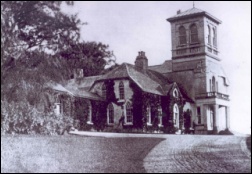 A
Celtic Cross and some boundary walls situated in the field adjoining the
Community Centre are all that remain of a big estate known locally as
the Cornwall Brady Estate. The big house, which once adorned the estate,
“Myshall Lodge” was built by Robert Cornwall, a native of Tyrone, who
acquired land in Co. Carlow during the latter half of the 18th century.
The male line of the family died out with the last descendant leaving
Myshall in 1915 and the house (unoccupied) was burned in 1922 during the
Civil War.
A
Celtic Cross and some boundary walls situated in the field adjoining the
Community Centre are all that remain of a big estate known locally as
the Cornwall Brady Estate. The big house, which once adorned the estate,
“Myshall Lodge” was built by Robert Cornwall, a native of Tyrone, who
acquired land in Co. Carlow during the latter half of the 18th century.
The male line of the family died out with the last descendant leaving
Myshall in 1915 and the house (unoccupied) was burned in 1922 during the
Civil War.
HOLLYBROOK HOUSE
 This
house was built by Henry Feltus who married Elizabeth Blake,
both children of Englishmen, who settled in this area in the reign of
William III (1688-1702).
The present owner of
Hollybrook House, Daniel
O’Neill, carries on a tradition of bone-setting – a gift inherited from
his ancestors. This unique gift has been part of the
O’Neill family and
this area of Co. Carlow for over four hundred years. In the 19th century
tradition held that there was never a child born alive in the house and
that the last one had flown out the window as a crow, but that story has
been proven incorrect in recent times. The present owner has also gained
celebrity status through his ownership of a popular race horse “Danoli”
the 1997 Hennessy Gold Cup winner.
This
house was built by Henry Feltus who married Elizabeth Blake,
both children of Englishmen, who settled in this area in the reign of
William III (1688-1702).
The present owner of
Hollybrook House, Daniel
O’Neill, carries on a tradition of bone-setting – a gift inherited from
his ancestors. This unique gift has been part of the
O’Neill family and
this area of Co. Carlow for over four hundred years. In the 19th century
tradition held that there was never a child born alive in the house and
that the last one had flown out the window as a crow, but that story has
been proven incorrect in recent times. The present owner has also gained
celebrity status through his ownership of a popular race horse “Danoli”
the 1997 Hennessy Gold Cup winner.
BARRAGH CHURCH AND CARNAVANE WELL
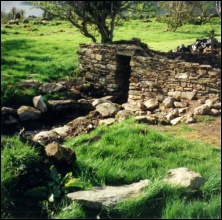 St. Finian was the founder of the Barragh Church where he laboured
for seven years. All that remains of the 78’ x 21’ church is one gable
and part of the walls. In 1650 Cromwellian soldiers attacked the church.
St. Finian was the founder of the Barragh Church where he laboured
for seven years. All that remains of the 78’ x 21’ church is one gable
and part of the walls. In 1650 Cromwellian soldiers attacked the church.
The water of Carnavane Well close by is said to cure soreness of eyes,
pains and debility of the limbs and all body ailments. Pilgrimage to the
well was quite popular in ancient times; up to the early 1900's; locals
came to pray there and delicate children were bathed in a granite stone
trough outside the entrance to the well. It was enclosed with two stone
walls to the east and west and was roofed over. There is a bigger well a
few yards away from the first and there may even have been a third well
at the site.
KILLOUGHTERNANE CHURCH AND WELL (The White Church)
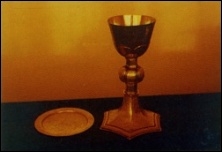 At
Killoughternane about four miles from Myshall a tiny church overlooks the road.
It has antae or projecting walls, an architectural feature that foes back to the
temples of Ancient Greece. The church was founded by St. Foirtcheirn in the late
5th century, although the existing roofless ruins of a single cell church are
later – 8th or 9th century. A well close by was completely lost sight of until
about the year 1880 when the owner found a corked bottle which contained a
document written in a foreign language which when translated was found to
indicate the position of the well. When it became known that well had been
discovered pilgrims came in great numbers to visit it and many cures were
recorded.
At
Killoughternane about four miles from Myshall a tiny church overlooks the road.
It has antae or projecting walls, an architectural feature that foes back to the
temples of Ancient Greece. The church was founded by St. Foirtcheirn in the late
5th century, although the existing roofless ruins of a single cell church are
later – 8th or 9th century. A well close by was completely lost sight of until
about the year 1880 when the owner found a corked bottle which contained a
document written in a foreign language which when translated was found to
indicate the position of the well. When it became known that well had been
discovered pilgrims came in great numbers to visit it and many cures were
recorded.
ST. MOLING’S CEMETERY, BALLINREE
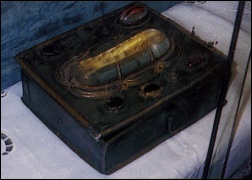 The interior of the ruins consist of a stoned building approx. 20
feet by 8 feet by 2 feet high and are called after celebrated St. Moling
who is buried in St. Mullins about 20 miles south of here. The ruined
building would seem to suggest a type of oratory and would indicate a
hermitage rather than a monastic settlement. St. Moling was a seventh
century Saint whose life was well documented. His greatest feat was the
remission of the Borumean Tribute which was a tax levied for five
hundred years by the High Kings of Ireland on the people of Leinster and had to
be paid every second year.
The interior of the ruins consist of a stoned building approx. 20
feet by 8 feet by 2 feet high and are called after celebrated St. Moling
who is buried in St. Mullins about 20 miles south of here. The ruined
building would seem to suggest a type of oratory and would indicate a
hermitage rather than a monastic settlement. St. Moling was a seventh
century Saint whose life was well documented. His greatest feat was the
remission of the Borumean Tribute which was a tax levied for five
hundred years by the High Kings of Ireland on the people of Leinster and had to
be paid every second year.
